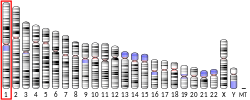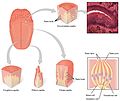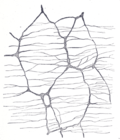type 1 member 3 is a protein that in humans is encoded by the TAS1R3 gene. The TAS1R3 gene encodes the human homolog of mouse Sac taste receptor, a major...
12 KB (1,536 words) - 11:56, 3 September 2024
families:[citation needed] Type 1, sweet, first characterized in 2001: TAS1R2 – TAS1R3 Type 2, bitter, first characterized in 2000: In humans there are 25 known...
42 KB (4,345 words) - 04:01, 9 September 2024
umami taste. Sweet and umami tastes both utilize the taste receptor subunit TAS1R3, with salt taste blockers reducing discrimination between monosodium glutamate...
35 KB (3,767 words) - 10:54, 28 September 2024
receptors. Positively, their taste buds possess the two receptors TAS1R1 and TAS1R3 needed to detect umami. These receptors contain molecular changes that reduce...
20 KB (2,385 words) - 18:31, 5 June 2024
loss of the sole umami taste receptor, encoded by the genes TAS1R1 and TAS1R3 (also known as T1R1 and T1R3), resulting from two frameshift mutations within...
105 KB (10,941 words) - 07:53, 25 September 2024
exhibits taste receptors similar to the ones in the tongue. The taste receptor TAS1R3 and the taste G protein gustducin are two of the most common. These receptors...
12 KB (1,431 words) - 09:16, 6 July 2024
heterodimer G protein-coupled receptor formed by the proteins TAS1R2 and TAS1R3. Rodents do not experience aspartame as sweet-tasting, due to differences...
61 KB (5,683 words) - 23:03, 10 September 2024
disappearance of symptoms in all affected workers. Thaumatin interacts with human TAS1R3 receptor to produce a sweet taste. The interacting residues are specific...
11 KB (1,219 words) - 12:56, 3 September 2024
tastes slightly sweet to humans, with the effect mediated by the TAS1R2/TAS1R3 taste receptor. Rats given a choice between distilled normal water and heavy...
83 KB (9,662 words) - 21:27, 24 September 2024
an intense sweet taste because it stimulates the sweet receptor TAS1R2+TAS1R3 in humans, although this is species-dependent, as the equivalent receptor...
9 KB (869 words) - 15:36, 11 September 2024
Rong M, Liu Z, Campagne F, Weinstein H, Damak S, Margolskee RF (2001). "Tas1r3, encoding a new candidate taste receptor, is allelic to the sweet responsiveness...
34 KB (3,882 words) - 07:21, 27 September 2024
recent study, lactisole acts on a sweet taste receptor heteromer of the TAS1R3 sweet protein receptor in humans, but not on its rodent counterpart. The...
6 KB (544 words) - 16:37, 23 September 2024
Taste receptor, type 1, member 2 (TAS1R2) Taste receptor, type 1, member 3 (TAS1R3) Class C Orphan receptors GPR158 (GPR158) GPR179 (GPR179) GPR156 (GPR156)...
4 KB (251 words) - 19:09, 28 June 2022
genotype of the taste receptor protein, taste receptor type 1 member 3 (TAS1R3), that enables them to taste the protein, brazzein. To humans, the fruit...
17 KB (1,810 words) - 02:33, 29 July 2024
Curculin appears to use a unique binding site at the amino terminal of TAS1R3. Like most proteins, curculin is susceptible to heat. At a temperature of...
8 KB (885 words) - 17:49, 25 August 2024
A2RTX5 16288 TAS1R1 HGNC:14448 Q7RTX1 16289 TAS1R2 HGNC:14905 Q8TE23 16290 TAS1R3 HGNC:15661 Q7RTX0 16291 TAS2R1 HGNC:14909 Q9NYW7 16292 TAS2R3 HGNC:14910...
242 KB (17 words) - 23:17, 27 April 2024
taste receptor T1R1+3. This receptor is formed as a dimer of the TAS1R1 and TAS1R3 proteins. Moreover, the TAS1R1 protein is not functional outside of formation...
10 KB (1,285 words) - 02:24, 29 November 2023
Z.; Campagne, F.; Weinstein, H.; Damak, S.; Margolskee, R.F. (2001). "Tas1r3, encoding a new candidate taste receptor, is allelic to the sweet responsiveness...
8 KB (736 words) - 17:20, 2 June 2023
olfactory and taste cell function. Identified the Sac locus coding for the TAS1R3 receptor, one of the receptors for the sweet taste. Established use of chemosignals...
14 KB (1,556 words) - 01:57, 8 July 2024
channels are not expressed together in taste buds. Taste receptor TAS1R1 TAS1R3 GRCh38: Ensembl release 89: ENSG00000179002 – Ensembl, May 2017 GRCm38:...
13 KB (1,637 words) - 04:32, 4 September 2024
the mouse saccharin preference (Sac) genetic locus as a gene encoding the TAS1R3 taste receptor was the first successful positional cloning of a behavioral...
9 KB (826 words) - 16:24, 2 July 2023
bitterness, sweetness, and umami, are the cell-bound GPRs TAS1R2/TAS1R3, TAS1R1/TAS1R3, and multiple subtypes of TAS2R for sweetness, umami, and bitterness...
59 KB (7,458 words) - 19:14, 27 March 2024

















